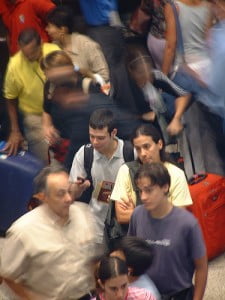 Research undertaken this year at the University of Toronto suggests that people’s moods impact literally on what they’re able to see. Published in the Journal of Neuroscience, the study indicated that people in a good mood took in more information when they look at something, whereas those in a bad mood are more likely to see with tunnel vision.
Research undertaken this year at the University of Toronto suggests that people’s moods impact literally on what they’re able to see. Published in the Journal of Neuroscience, the study indicated that people in a good mood took in more information when they look at something, whereas those in a bad mood are more likely to see with tunnel vision.
Being in a good mood and taking in more information may be positive or negative depending on the circumstances. However from a retailing perspective, particularly if you’re walking through a mall or airport, its certainly going to be beneficial.
“Good moods enhance the literal size of the window through which we see the world,” Taylor Schmitz, a graduate student in psychology at the University of Toronto and lead author of the study, says in a written statement. “The upside of this is that we can see things from a more global, or integrative perspective. The downside is that this can lead to distraction on critical tasks that require narrow focus, such as operating dangerous machinery or airport screening of passenger baggage.”
Consider now the experience of most passengers in an airport. They’re typically stressed already (albeit not necessarily in a bad mood because many are travelling on a holiday with all the excitement that involves), they queue to check in, they queue again for security scanning, queue again for immigration (in international terminals). The natural bi-product of all this queuing, particularly if its not handled well, is a bad mood. This develops tunnel-vision and they start to focus on buying only what they have to and head for the gate. Their perception of options reduces and indeed the presentation of too many options within their tunnelled vision just gets annoying and further compounds their bad mood.
Its not surprising therefore that our own research in airports has shown a strong negative correlation between queue length (and poorly managed queues) and Passenger Spend Rates (PSRs). Indeed the very rough rule of thumb we found is that the first 3-5 minutes in a checkin/security queue are “free” of impact (the variance is really a factor of how well the queue operates not only the duration) and delays beyond that start to eat away at PSRs exponentially.
The impact of people’s bad mood and their tunnel vision can then easily be compounded by their experience immediately after these queues. If wayfinding is poor, they’re faced with too many choices, service experience is sub-standard or products they want are out of stock, their mood further deteriorates. This makes the retail usages (or other elements of the passenger experience) immediately after these queue points, critical. Not only are they the highest risk in terms of the flow-on impact of tunnel-vision created by bad experiences with queues, they also play a critical role in either lifting the mood or making it worse depending on how they’re handled.
Its perhaps interesting therefore that so many airports are opting for walkthru duty free immediately after security/immigration – the biggest earner for an airport being placed in the highest risk position. On the positive side however, as the highest revenue generator for most airports, having this usage first means that any improvements to mood generated through improvements in queue processes or the overall passenger experience getting airside, is likely to have very significant financial benefits.
Airports put so much emphasis on increasing retail spend, usually by increasing the number of shops, improving the ambience of the retail area and expanding the retail mix. However there are very strong indications that they would get as much if not more benefit by investing in the processes passengers have to go through to get to the retail area, and ensure they’re not in a bad mood. Otherwise, they’re simply not going to see their wonderful shopping zones.
Image : Flickr/Junctions
![Reblog this post [with Zemanta]](http://img.zemanta.com/reblog_e.png?x-id=db696031-5e12-4fd6-babb-ca95e785780d)



